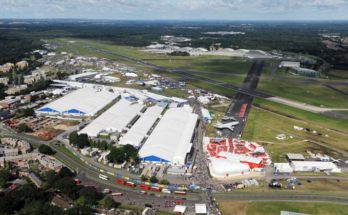by Richard Pettibone, Aerospace & Defense Companies Analyst, Forecast International.
After years of difficulty, Bombardier has made some bold moves under its five-year restructuring plan, begun in 2015.
The most dramatic of these steps has been the formation of a joint venture, majority led by Airbus, to take over the CSeries program. This effort, begun in late 2017, became official in July 2018 when Airbus assumed a 50.01 percent controlling stake in the program. The CSeries was quickly rebranded as the Airbus A220 after the joint venture took control of the program. The two new models in Airbus’ lineup, the A220-100 and A220-300, were formerly known as the CS100 and CS300, respectively.
The CSeries had been a risky venture for the company insofar as it straddles the high end of the regional jet market and the low end of the narrowbody market – hypercompetitive Airbus and Boeing territory. Debt burden over the delayed program had also been a drag on Bombardier in recent years – so much so that in 2016, Québec’s provincial government finalized a $1 billion investment to bail out the CSeries program. In return, Investissement Québec became a minority partner in the CSeries program. As part of the deal, A220 operations will remain in Québec for at least 20 years. The investment introduced a new flow of cash to support the aircraft’s entry into service and production ramp-up. Currently, under Airbus, Investissement Québec holds a 16 percent interest, with Bombardier holding the remaining 34 percent.
Meanwhile, Bombardier’s key rival, Embraer, is in the process of joining with Airbus’ key competitor, Boeing. In this counter punch, Boeing and Embraer recently laid the foundation of a new commercial aircraft entity, majority owned by Boeing. Under this venture, Boeing will use its marketing and support operations to push the E190-E2 and E195-E2 aircraft against the rebranded Airbus A220-100. The deal is a bit more complex than the Airbus/Bombardier tie-up and is not expected to be completed until sometime in 2019.
With its CSeries now in stable hands, Bombardier is turning its attention toward its regional aircraft offerings. Here the company offers the Q400 turboprop and CRJ and Global series of regional jets. The market here has been a difficult one in recent years. The operating environment for regional carriers has become increasingly difficult, as industry consolidation has shrunk the number of major legacy airlines in the U.S., the largest geographic market for regional aircraft, from six to three. This situation is echoed in Europe, which also faces a more strict regulatory environment and increased competition from low-fare carriers.
Despite these challenges, Bombardier sees rising demand for both regional jets and turboprops. To this end, the company has introduced several new variants such as the Global 5500 and 6500 with more powerful and fuel-efficient engines as well as other improvements. These models are aimed at standing out in the hypercompetitive regional jet market as new models from competitors such as Dassault (Falcon 7X) and Gulfstream (G600) compete for sales.
Bombardier’s new management team continues to adapt and to tweak strategy to maintain the company’s renewed momentum. If the company can continue this trend over the next few years, Bombardier Aerospace should emerge as whole and healthy once more.
For over 15 years, Richard has authored Forecast International’s Defense & Aerospace Companies series, Volume I (North America) and Volume II (International) services. The two books provide detailed outlines and analyses of major aerospace and defense contractors.
A military history enthusiast, Richard began at Forecast International as editor of the World Weapons Weekly newsletter. As the Internet grew in importance as a research tool, he helped design the company's Forecast Intelligence Center and currently coordinates the EMarket Alert newsletters for clients. Richard also manages social media efforts, including two new blogs: Defense & Security Monitor, covering defense systems and international issues, and Flight Plan, which focuses on commercial aviation and space systems. For over 30 years, Richard has authored the Defense & Aerospace Companies, Volume I (North America) and Volume II (International) services. The two books provide detailed data on major aerospace and defense contractors. He also edits the International Contractors service, a database that tracks all the contractors involved in the programs covered in the FI library. More recently he was appointed Manager, Information Services Group (ISG), a new unit that encompasses developing outbound content for both Forecast International and Military Periscope.




